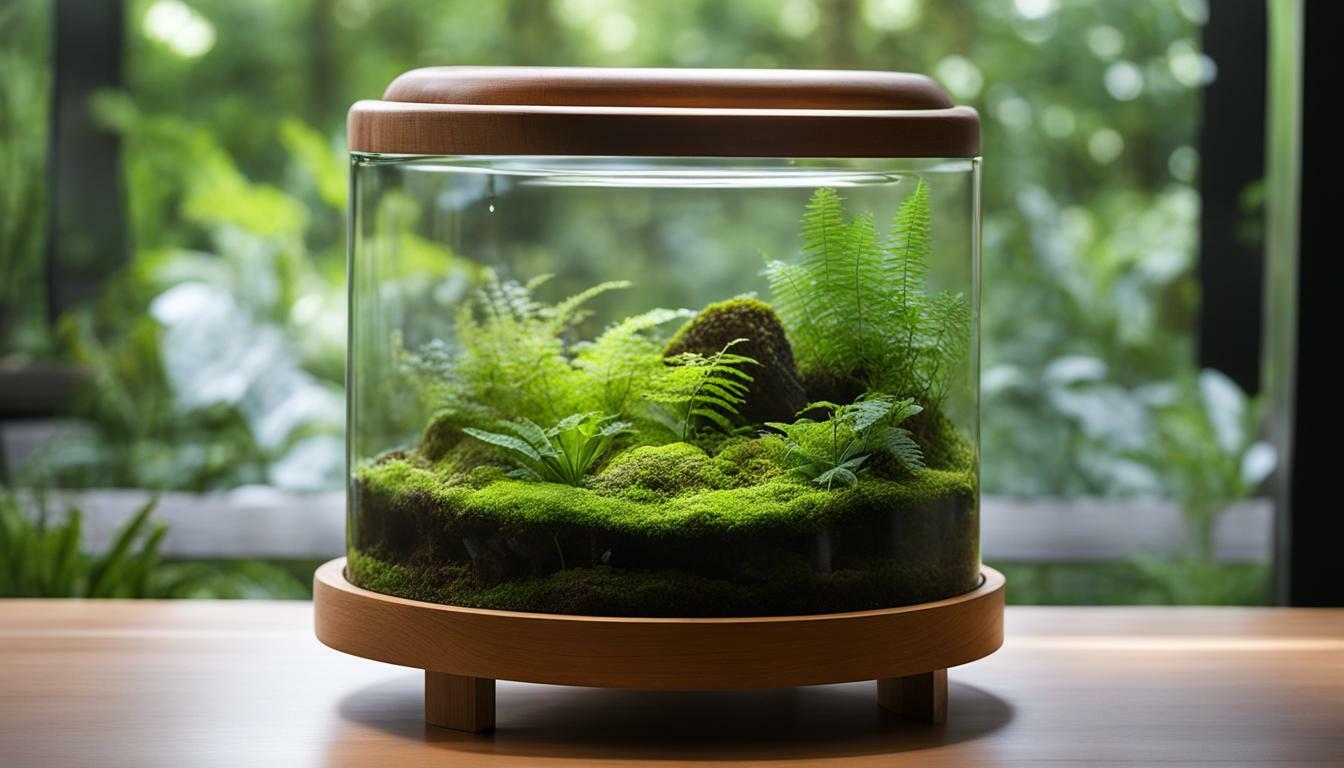Proper air circulation is crucial for maintaining a healthy and balanced terrarium environment. Understanding the essentials of air circulation is key to mastering terrarium care and ensuring the longevity of your indoor ecosystem. In this section, we will delve into the importance of air circulation in terrariums and provide you with the necessary knowledge to create a thriving environment for your plants.
When it comes to terrarium care, air circulation plays a vital role in the overall health and well-being of your plants. It helps to regulate temperature and humidity levels, prevents the buildup of excess moisture, and provides fresh air to support plant growth. By understanding the importance of air circulation, you can effectively address common issues such as mold and fungus growth, algal blooms, pests, and poor drainage.
Key Takeaways:
- Proper air circulation is essential for maintaining a healthy and balanced terrarium environment.
- Avoid excessive condensation caused by direct sunlight by providing appropriate lighting and temperature conditions.
- Monitor and adjust condensation levels to prevent excess moisture.
- Observe changes in plants to identify their specific needs, including watering requirements.
- Address issues of mold, fungus growth, algal blooms, pests, and poor drainage through improved air circulation and proper terrarium substrates.
Understanding Lighting and Temperature Conditions
Creating optimal lighting and temperature conditions is key to promoting proper air circulation in your terrarium. The right balance of light and temperature ensures that your terrarium ecosystem thrives and maintains a healthy environment for your plants. Here are some important considerations for achieving the ideal conditions:
Lighting:
Plants in a terrarium require the right amount and quality of light to carry out photosynthesis effectively. Place your terrarium in an area with indirect sunlight or use artificial lights specifically designed for plant growth. Avoid placing the terrarium in direct sunlight, as this can lead to excessive condensation and heat buildup.
Temperature:
Temperature plays a crucial role in maintaining the balance of your terrarium ecosystem. Most terrarium plants thrive in temperatures between 65°F and 75°F (18°C – 24°C). Keep your terrarium away from drafty areas or heat sources, which can disrupt air circulation and alter the temperature inside the terrarium.
To ensure proper air circulation, consider incorporating natural and artificial means:
- Position small fans near your terrarium to enhance air movement.
- Open the lid occasionally to allow fresh air exchange, especially if you notice excessive condensation.
- Utilize vents or air holes in the terrarium container to facilitate airflow.
Remember, maintaining the right lighting and temperature conditions in your terrarium is essential for promoting proper air circulation. By understanding these factors and implementing the necessary measures, you’ll create an environment that supports the health and longevity of your terrarium ecosystem.
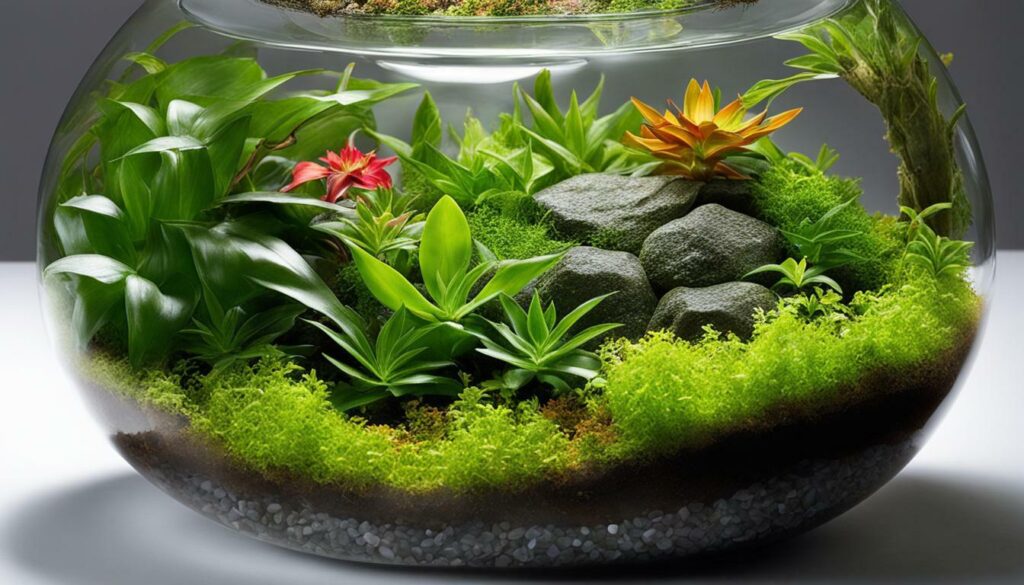
| Lighting | Temperature |
|---|---|
| Ensure indirect sunlight or use artificial lights | Maintain a temperature between 65°F – 75°F (18°C – 24°C) |
| Avoid direct sunlight to prevent excessive condensation | Avoid drafty areas and heat sources |
| Consider natural and artificial means for air circulation | Open the lid occasionally for fresh air exchange |
Monitoring and Adjusting Condensation Levels
Consistently monitoring and adjusting condensation levels is essential for ensuring adequate air circulation in your terrarium. Excessive condensation can indicate an imbalance in moisture levels, which can have detrimental effects on the health of your plants. To maintain optimal conditions, it’s important to take proactive measures to manage condensation levels effectively.
One method to control condensation is by removing the lid of your terrarium for a period of time. This allows excess moisture to escape and fresh air to circulate, promoting a healthier environment for your plants. However, it’s important to strike a balance – too much exposure to open air can lead to dehydration and damage to your plants. Experiment with different durations and observe how your terrarium responds to find the right amount of time to keep the lid off.
To maintain a balanced moisture level, regularly check the walls and lid of your terrarium for excessive moisture buildup. If you notice a significant amount of condensation, consider using a soft cloth or paper towel to wipe it away. This will help prevent the accumulation of excess moisture, decreasing the risk of mold and fungus growth. Additionally, you can place a small fan near your terrarium on a low setting to promote airflow and prevent stagnant conditions.
| Benefits of Monitoring and Adjusting Condensation Levels |
|---|
| 1. Prevents excess moisture buildup |
| 2. Reduces the risk of mold and fungus growth |
| 3. Promotes optimal air circulation |
| 4. Maintains a healthier environment for terrarium plants |
Key Takeaway
By monitoring and adjusting condensation levels in your terrarium, you can ensure adequate air circulation for the well-being of your plants. Regularly removing the lid, wiping away excess moisture, and promoting airflow are effective strategies to maintain a balanced and healthy terrarium environment. By implementing these practices, you can create an optimal ecosystem where your terrarium plants can thrive.
Identifying Signs of Plant Needs
Paying close attention to the condition of your terrarium plants can help you address any air circulation issues they might be experiencing. By observing changes in their appearance and behavior, you can identify specific plant needs and take appropriate measures to ensure their well-being.
Wilting leaves and pale green moss are common signs of dehydration, indicating the need for watering. However, it’s essential to strike a balance, as overwatering can lead to excess moisture and hinder proper air circulation. The amount of water required depends on the size of the terrarium and the specific plants housed within it. To avoid water accumulation, consider using a well-draining substrate and monitor moisture levels regularly.
Another key indicator is the presence of yellowing or browning foliage, which can suggest poor air circulation. Insufficient airflow can impede plant respiration and transpiration, leading to the decline of your terrarium ecosystem. To address this issue, incorporating gentle air movement through natural ventilation or the use of a small fan can significantly improve air circulation and promote plant health. Moreover, removing any decaying organic matter can prevent the buildup of harmful gases and maintain a fresh environment for your terrarium plants.
It’s important to note that every terrarium is unique, and different plants have varying care requirements. By being attentive to the needs of your terrarium plants, you can create an optimal environment that fosters their growth and ensures the success of your indoor ecosystem.
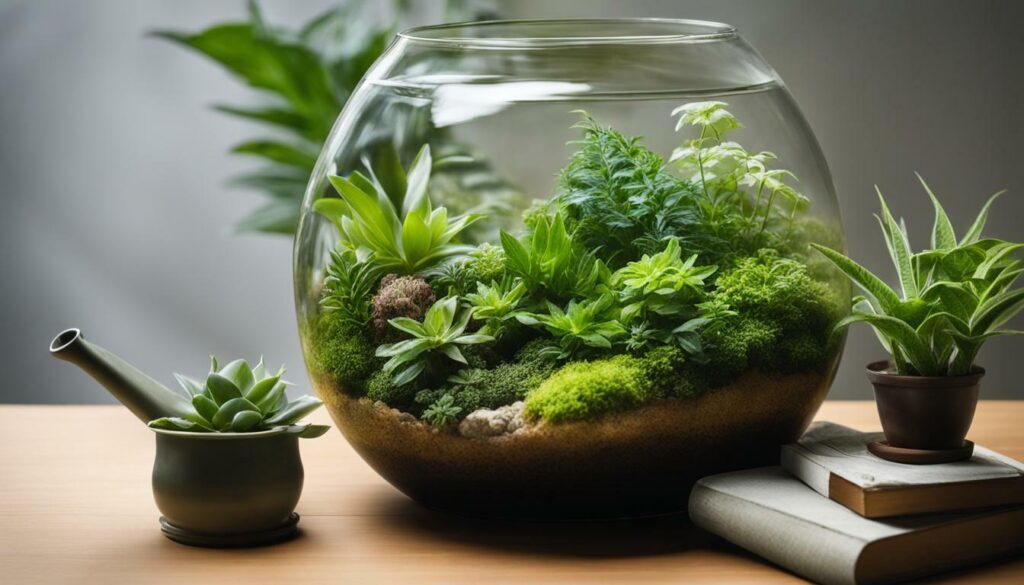
Managing Mold and Fungus Growth
Mold and fungus growth in terrariums can be managed by promoting better air circulation within the enclosed environment. Proper air circulation helps to reduce excess moisture, which is a common trigger for mold and fungus growth. When moisture accumulates in a terrarium, it creates a damp environment that fosters the growth of these unwanted organisms.
To improve air circulation, it’s important to remove any visible mold or fungus promptly. This can be done by gently wiping affected areas with a clean cloth or paper towel. Additionally, opening the lid of the terrarium for a short period each day allows fresh air to circulate and helps to dry out the excess moisture.
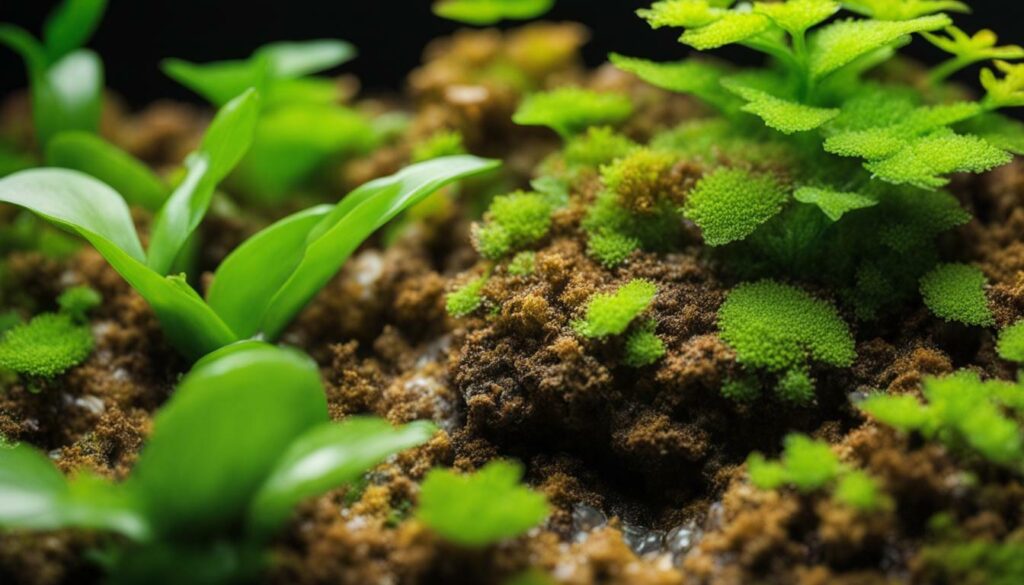
Another strategy to prevent mold and fungus growth is to position the terrarium away from direct sunlight. While plants need light to photosynthesize, excessive sunlight can lead to increased condensation, providing an ideal environment for mold and fungus to thrive. By carefully managing the lighting conditions, you can maintain a balance that supports plant growth while minimizing the risk of mold and fungus.
Overall, maintaining proper air circulation is key to managing mold and fungus growth in terrariums. By monitoring moisture levels, removing visible mold or fungus, and allowing fresh air to circulate, you can create a healthier environment that promotes the longevity and vibrancy of your terrarium plants.
Addressing Algal Blooms in Terrariums
Algal blooms can be a common problem in terrariums but can be controlled by promoting adequate air circulation. These blooms occur when there is an excess of nutrients, moisture, and light within the enclosed environment. The presence of algae not only affects the aesthetics of the terrarium but also hinders the growth and health of other plants.
To address algal blooms, it is important to first remove any affected areas, such as leaves or moss covered in algae. By physically removing the visible algae, you can prevent its spread and allow other plants to thrive. Alongside this, reducing light exposure can help control the growth of algae. Placing the terrarium in a location where it receives indirect sunlight or adding curtains or blinds to filter the light can create a less favorable environment for algae.
Another effective strategy to combat algal blooms is to introduce plants that consume the excess nutrients that contribute to algae growth. Plants such as floating bladderwort or hornwort can help absorb excess nutrients and compete with algae for resources. Adding a layer of activated carbon to the terrarium can also aid in absorbing excess nutrients and improving water quality.
By addressing algal blooms and implementing these strategies, you can maintain a healthy and balanced environment in your terrarium, ensuring optimal growth for all the plants within it. Promoting good air circulation, alongside proper lighting, temperature control, and appropriate substrate selection, is essential for a thriving terrarium ecosystem.
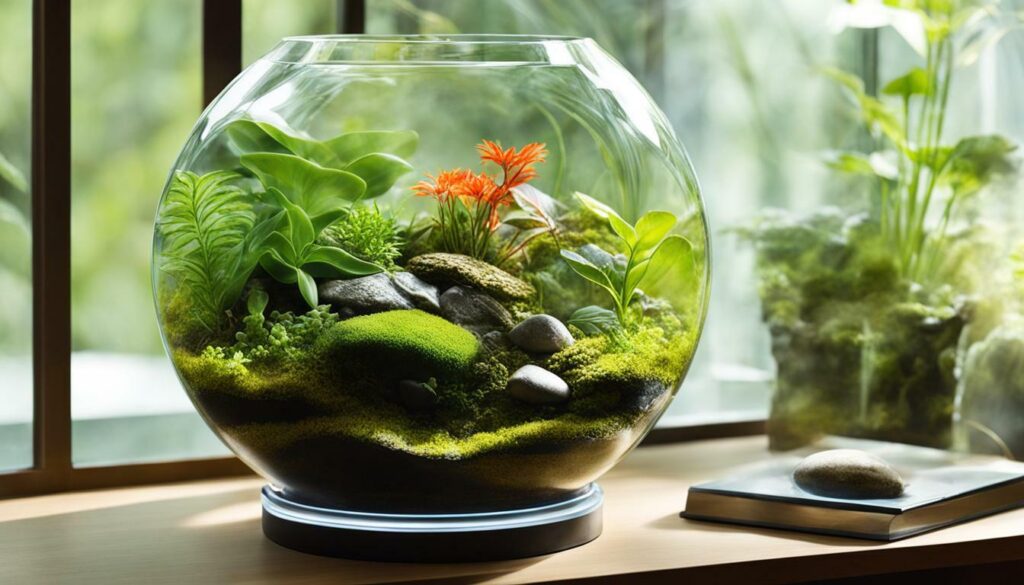
| Plant Name | Characteristics |
|---|---|
| Floating Bladderwort (Utricularia) | Small, carnivorous plant that consumes excess nutrients |
| Hornwort (Ceratophyllum demersum) | Dense, oxygenating plant that outcompetes algae for nutrients |
Managing Pests and Poor Drainage
Pests and poor drainage can be effectively managed in terrariums by ensuring sufficient air circulation throughout the ecosystem. Adequate airflow helps deter mites and other pests from taking hold, as they thrive in stagnant conditions. Additionally, stagnant air can lead to increased moisture, which can result in poor drainage and create a breeding ground for pests and mold.
To improve air circulation and minimize the risk of pests, consider the following tips:
- Place the terrarium in a location with indirect sunlight. This helps to prevent excessive condensation and maintain a drier environment.
- Regularly open the terrarium lid for a short period of time to allow fresh air to circulate. This can be done every few days or whenever excessive moisture is observed.
- Ensure the terrarium has proper drainage by using a layer of gravel or activated charcoal at the bottom before adding the substrate. This helps to prevent water from pooling and creating a stagnant environment.
By implementing these practices, you can create an environment that is less favorable for pests and promotes healthy airflow and drainage. Remember to observe the plants and soil regularly to detect any signs of pests or poor drainage and take appropriate action.
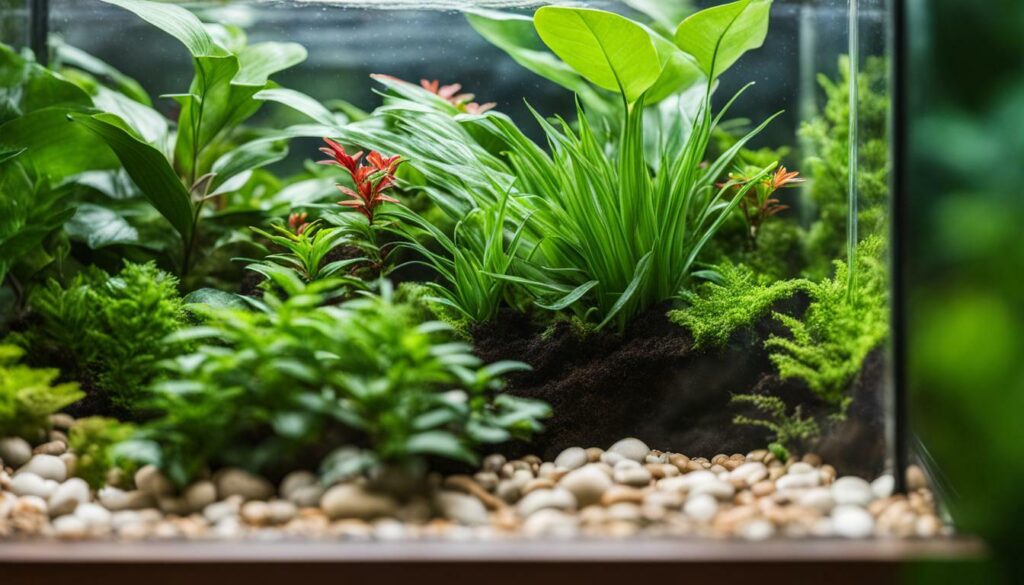
| Pest | Symptoms | Treatment |
|---|---|---|
| Mites | Visible tiny pests on the leaves or soil. Yellowing or wilting leaves. | Isolate affected plants and clean the terrarium thoroughly. Consider using natural pest deterrents, such as neem oil or insecticidal soap. |
| Mold | Fuzzy, discolored patches on the soil or plant surfaces. Musty smell. | Remove the affected areas, improve air circulation, and adjust moisture levels. Consider using a fungicide if the problem persists. |
Choosing the Right Substrates and Materials
Choosing the right substrates and materials is essential for creating a well-ventilated terrarium environment. The type of substrate you use can greatly impact the air circulation within the terrarium. Opt for materials that are porous and allow for proper drainage, such as sphagnum moss, gravel, or a mixture of potting soil and sand. This will prevent water from stagnating and promote airflow, ensuring a healthy ecosystem for your terrarium plants.
Additionally, consider the size and shape of the materials used. Larger pieces of substrate, such as bark or stones, can create pockets of air within the terrarium, enhancing air circulation. Smaller materials, like fine sand, may compact easily, restricting airflow. It’s important to strike a balance between texture and density to achieve optimal ventilation.
| Substrate | Description |
|---|---|
| Sphagnum Moss | A highly porous material that retains moisture while allowing for good air circulation. |
| Gravel | Provides excellent drainage and helps prevent water stagnation. |
| Potting Soil and Sand Mix | A blend that allows for adequate airflow and water retention. |
When it comes to selecting materials for decoration, opt for items that won’t obstruct airflow or trap moisture. Avoid using materials like plastic or non-breathable glass containers, as they can create a stagnant environment. Instead, consider natural elements like cork bark, driftwood, or terracotta pots, which allow for air circulation and help maintain a healthy balance of humidity within the terrarium.
Remember, choosing the right substrates and materials is just one piece of the puzzle for creating a well-ventilated terrarium environment. Be sure to also consider other factors like lighting, temperature, and plant needs, as they all play a role in maintaining a thriving indoor ecosystem.
Creating a Balanced and Healthy Environment
By following these tips and practices, you can create a balanced and healthy environment for your terrarium plants to thrive. It’s important to start by selecting the right substrates and materials that promote optimal air circulation and drainage. The choice of these components can greatly impact the overall health of your terrarium ecosystem.
Regular monitoring and observation of your terrarium plants is essential. Look for any signs of changes like wilting leaves or pale green moss, as these can indicate specific needs, including watering requirements. The amount of water needed will depend on the size of your terrarium, so it’s important to find the right balance to avoid overwatering or underwatering.
Maintaining good air circulation is crucial for preventing common issues like mold, fungus, and algal blooms. If you notice any of these problems, it’s important to address them promptly. Remove affected areas and allow for proper air circulation to help dry out the terrarium. You can also reduce light exposure to control algal growth and consider adding plants that consume excess nutrients, helping to minimize the risk of algae blooms.
Lastly, pests and poor drainage can also impact the health of your terrarium. Mites are a common pest that can affect the well-being of your plants. Ensure your terrarium has proper ventilation and consider using natural remedies or insecticidal soaps to manage these pests. Additionally, poor drainage can lead to stagnant water, which can create an unhealthy environment. Choose substrates and materials that promote proper drainage, allowing excess water to flow out and preventing water from becoming trapped.
Table 1: Recommended Substrates and Materials for Terrariums
| Substrate/Material | Description |
|---|---|
| Peat moss | Retains moisture and promotes healthy root growth. |
| Orchid bark | Provides excellent drainage and aeration for terrarium plants. |
| Activated charcoal | Helps to filter and purify the air within the terrarium. |
| Perlite | Improves soil drainage and aeration. |
| Sphagnum moss | Retains moisture and creates a humid environment for moisture-loving plants. |
By implementing these recommendations and following the tips provided, you can ensure that your terrarium has optimal air circulation, proper moisture levels, and a healthy environment for your plants to thrive.
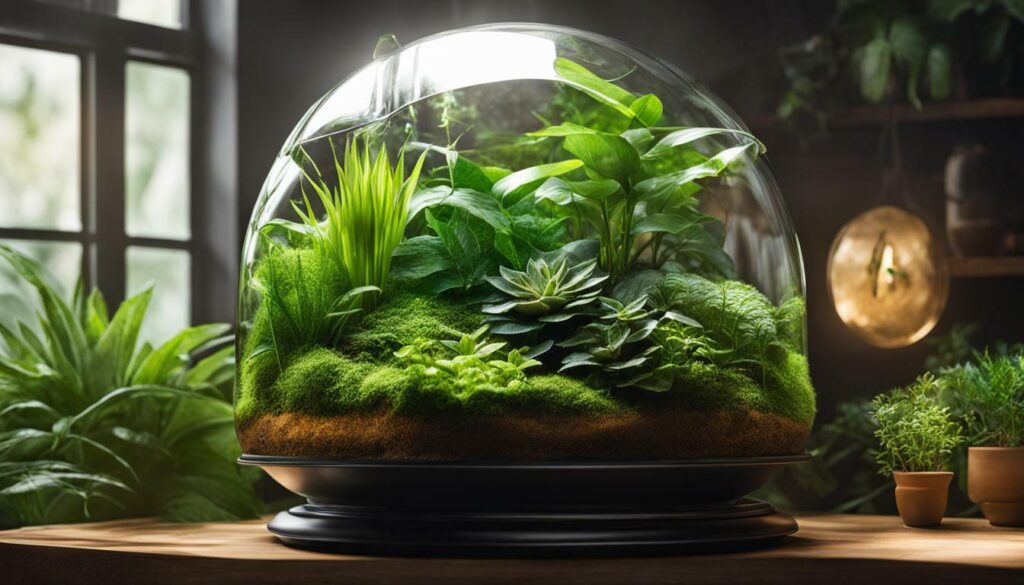
Terrarium ventilation is crucial for ensuring the overall health and well-being of your terrarium plants. Good ventilation promotes air exchange, maintains optimal air quality, and helps prevent issues such as excessive condensation, mold, and pest infestations. Proper air circulation within the terrarium creates a balanced and healthy environment, allowing plants to thrive.
One way to improve air circulation is by controlling lighting and temperature conditions. Avoid placing terrariums in direct sunlight, as this can lead to excessive condensation and create an environment conducive to mold and fungal growth. Instead, place your terrarium in a well-lit area with indirect sunlight, striking a balance between light and shade. Maintaining optimal temperature conditions also helps regulate air circulation, preventing stagnant air and the buildup of excessive moisture.
Monitoring and adjusting condensation levels is another essential aspect of maintaining proper air circulation. Excessive condensation indicates an imbalance in moisture levels, which can be remedied by temporarily removing the terrarium lid. By allowing fresh air to enter and circulate, you can help reduce moisture levels and prevent the accumulation of mold and fungus. However, it’s important to find the right balance, as too much airflow can lead to excessive drying of the terrarium.
Tips for Improving Terrarium Ventilation:
- Ensure the terrarium has adequate openings for air exchange, such as small ventilation holes or an open lid.
- Position the terrarium in a well-ventilated area of your home, away from drafts or stagnant air.
- Use a small fan on a low setting to promote gentle air circulation in the terrarium.
- Avoid overcrowding the terrarium with too many plants or decorations, as this can hinder airflow.
- Regularly clean and remove any dead plant material to maintain a clean and healthy environment.
By following these tips and maintaining proper ventilation, you can create an optimal environment for your terrarium plants to thrive. Remember to observe your terrarium regularly and make adjustments as needed to ensure a balanced and healthy ecosystem for your plants.
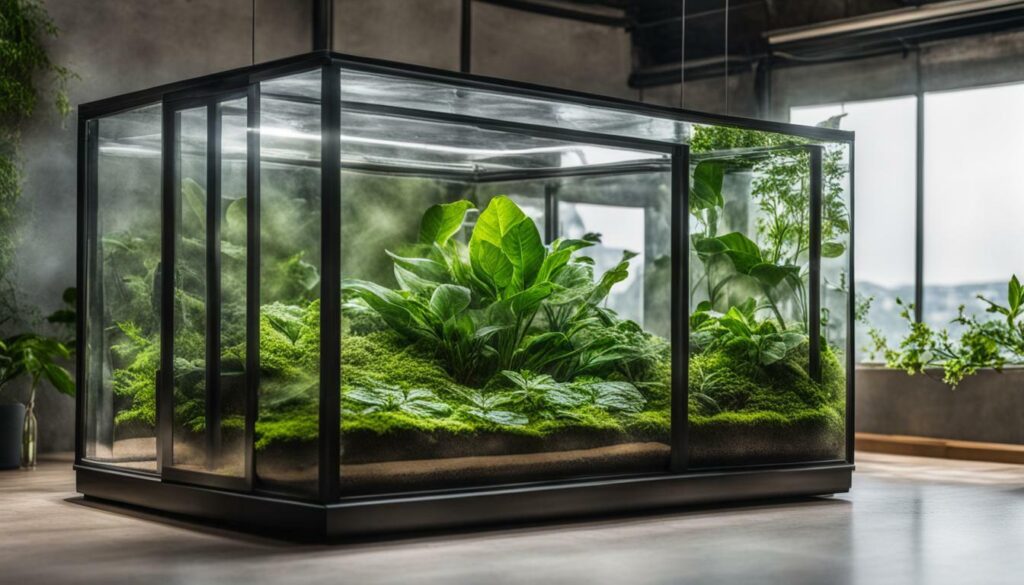
Enhancing air circulation in your terrarium can be achieved through implementing these best practices and proven techniques. Proper air circulation is essential for creating a thriving indoor ecosystem, as it helps maintain optimal moisture levels, prevents mold and fungus growth, and promotes the overall health of your terrarium plants.
Best Practices for Air Circulation
- Regularly remove the lid or open the terrarium for a few hours each week to allow fresh air to circulate. This helps prevent excessive condensation and allows excess moisture to evaporate.
- Position your terrarium away from direct sunlight to avoid overheating and excessive moisture buildup. Indirect light sources, such as filtered sunlight or fluorescent lights, are ideal for maintaining a stable temperature and humidity level.
- Include natural ventilation points in your terrarium design, such as small gaps or holes in the lid or side panels. This allows for the exchange of air without compromising the terrarium’s overall environment.
- Add a small fan or air circulation device near your terrarium to enhance airflow. Gentle air movement helps reduce stagnant conditions and improves overall ventilation.
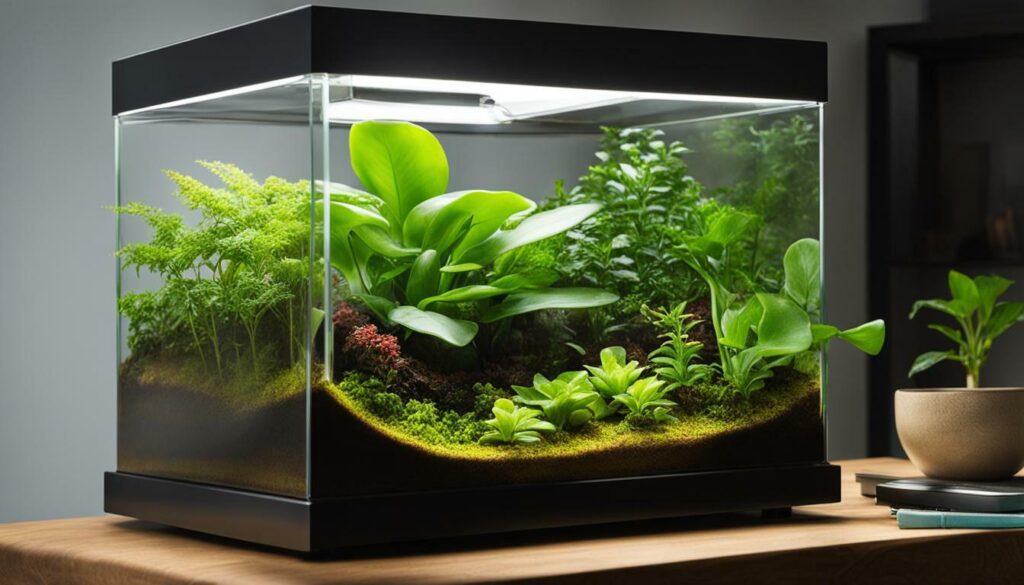
Proven Techniques for Optimal Air Circulation
Alongside best practices, there are additional techniques you can implement to further improve air circulation in your terrarium:
- Choose terrarium substrates and materials that allow for proper drainage. Good drainage prevents waterlogging and creates a suitable environment for roots to breathe.
- Trim any overgrown plants or moss that may obstruct airflow within the terrarium. Prune as needed to maintain a balanced and open ecosystem.
- Position decorative elements, such as rocks or ornaments, in a way that doesn’t block or impede air circulation. These elements should enhance the aesthetics of your terrarium without hindering the movement of air.
- Regularly monitor and adjust the humidity levels within your terrarium. Excess humidity can inhibit air circulation, so consider using a hygrometer to ensure optimal conditions.
By following these best practices and implementing proven techniques, you can create an environment that promotes healthy air circulation in your terrarium. Remember to regularly observe and adjust as needed to ensure the well-being of your plants and the overall longevity of your indoor ecosystem.
What Are the Best Air Circulation and Ventilation Practices for Terrarium Care?
When it comes to maintaining a healthy terrarium, proper ventilation solutions for terrarium care are essential. Good air circulation helps prevent mold and mildew growth, while also keeping the plants and animals within the terrarium healthy. Consider using small fans and strategically placed vents to ensure optimal air flow.
Conclusion
Proper air circulation is vital for the success of your terrarium, ensuring optimal conditions for your plants to flourish. By understanding the essentials of air circulation, you can create a thriving indoor ecosystem that mimics the natural environment.
One important aspect of terrarium care is providing the right lighting and temperature conditions. Direct sunlight can lead to excessive condensation, so it’s crucial to avoid placing your terrarium in direct sunlight. This will help prevent moisture buildup and maintain a healthy balance.
Monitoring and adjusting condensation levels is also key. Too much condensation can indicate excess moisture, which can be detrimental to your terrarium’s health. If you notice excessive condensation, consider removing the lid for a period of time to allow for better air circulation.
Observing changes in your plants is another essential practice. Wilting leaves or pale green moss may signal the need for watering. The amount of watering required will depend on the size of your terrarium, so it’s important to pay attention to your plants’ specific needs.
Common issues in terrariums include mold, fungus growth, and algal blooms. These can be addressed by improving air circulation. Removing any visible mold or fungus and allowing air to flow freely can help dry out the terrarium. To treat algal blooms, reduce light exposure and consider adding plants that consume the nutrients that contribute to algae growth.
Pests, such as mites, and poor drainage can also affect the health of your terrarium. Using proper terrarium substrates and materials can help alleviate these issues, ensuring optimal air circulation and drainage.
In summary, creating a balanced and healthy environment for your terrarium involves prioritizing air circulation. By following the essentials of terrarium care and implementing best practices, you can provide the ideal conditions for your plants to thrive and enjoy a long and beautiful life in your terrarium.
FAQ
How important is air circulation in terrarium care?
Air circulation is crucial for the health and well-being of terrarium plants. It helps regulate temperature, prevent excessive condensation, and maintain optimal moisture levels.
What should I do to avoid excessive condensation in my terrarium?
To avoid excessive condensation, it’s important to provide proper lighting and temperature conditions. Avoid placing your terrarium in direct sunlight and monitor condensation levels regularly.
How do I know if there is too much condensation in my terrarium?
Excessive condensation can be indicated by foggy or misty glass walls. If you notice too much condensation, you may need to remove the lid for a period of time to allow for air circulation and moisture balance.
How can I tell if my terrarium plants need watering?
Observing changes in plant appearance, such as wilting leaves and pale green moss, can be indicators that your terrarium plants need watering. The amount of water required depends on the size of your terrarium.
How do I address mold and fungus growth in my terrarium?
To address mold and fungus growth, it’s important to remove them promptly and improve air circulation within the terrarium. Allowing the terrarium to dry out and adding plants that consume excess nutrients can also help prevent their growth.
What should I do if there is an algal bloom in my terrarium?
If an algal bloom occurs, you should remove the affected areas, reduce light exposure, and add plants that consume the nutrients that contribute to algae growth. This will help restore balance to the terrarium environment.
How can I manage pests and poor drainage in my terrarium?
Managing pests, such as mites, and poor drainage involves improving air circulation within the terrarium. Using proper terrarium substrates and materials can also help address these issues.
What substrates and materials should I use for my terrarium?
It’s important to choose appropriate substrates and materials that promote optimal air circulation and drainage. This may include using a mix of potting soil, sand, and rocks, as well as selecting materials that allow for water to drain effectively.
How can I create a balanced and healthy environment in my terrarium?
Creating a balanced and healthy environment involves maintaining proper air circulation, monitoring plant needs, and addressing any issues promptly. Additionally, it’s important to provide the right amount of light and moisture for your terrarium plants to thrive.
Why is terrarium ventilation important?
Terrarium ventilation is important for air exchange and maintaining good air quality within the enclosed environment. It helps prevent stagnant air, excessive condensation, and the growth of harmful microorganisms.
How can I improve air circulation in my terrarium?
To improve air circulation, you can ensure proper lid placement, use fans or air circulation devices, and strategically position your terrarium in a well-ventilated area. Regularly monitoring and adjusting condensation levels is also beneficial.

